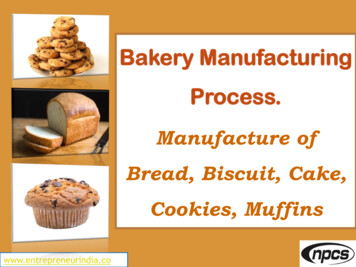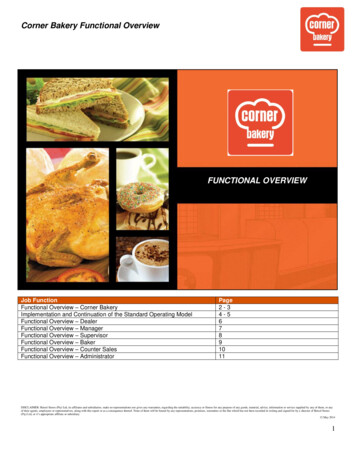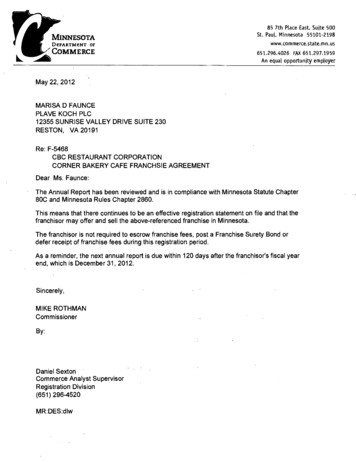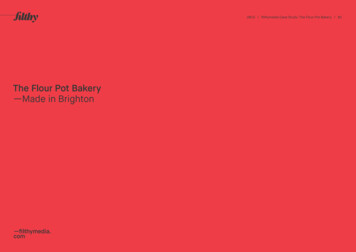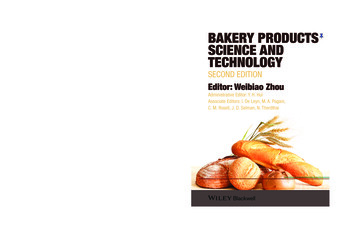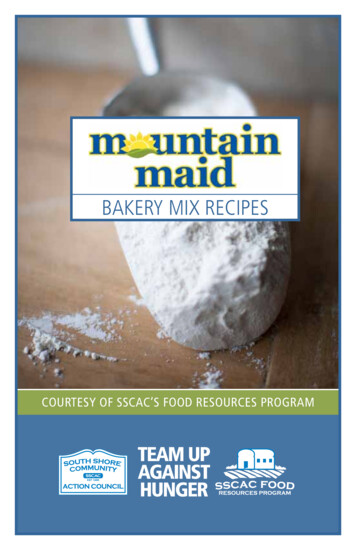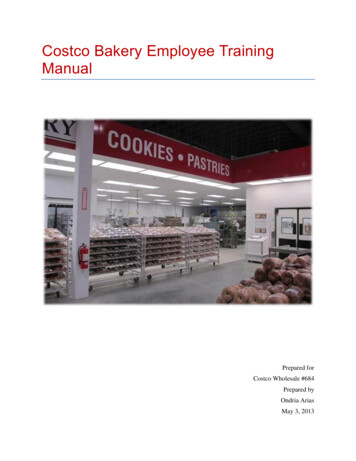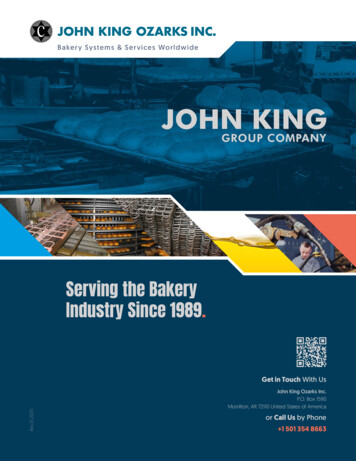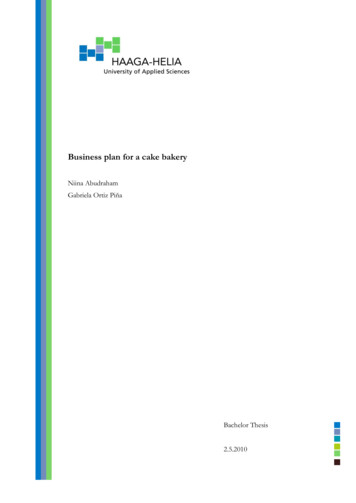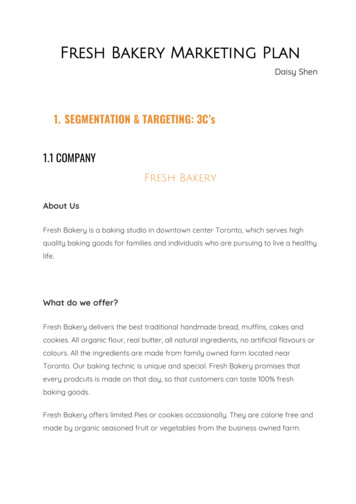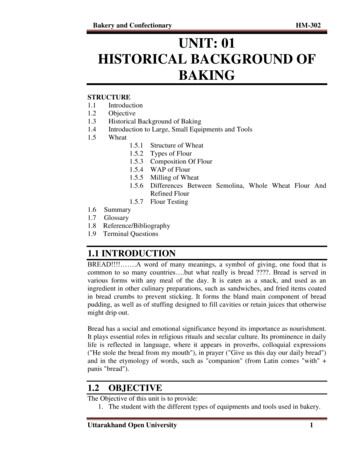
Transcription
Bakery and ConfectionaryHM-302UNIT: 01HISTORICAL BACKGROUND torical Background of Baking1.4Introduction to Large, Small Equipments and Tools1.5Wheat1.5.1 Structure of Wheat1.5.2 Types of Flour1.5.3 Composition Of Flour1.5.4 WAP of Flour1.5.5 Milling of Wheat1.5.6 Differences Between Semolina, Whole Wheat Flour AndRefined Flour1.5.7 Flour Testing1.6 Summary1.7 Glossary1.8 Reference/Bibliography1.9 Terminal Questions1.1 INTRODUCTIONBREAD!!!! .A word of many meanings, a symbol of giving, one food that iscommon to so many countries .but what really is bread ?. Bread is served invarious forms with any meal of the day. It is eaten as a snack, and used as aningredient in other culinary preparations, such as sandwiches, and fried items coatedin bread crumbs to prevent sticking. It forms the bland main component of breadpudding, as well as of stuffing designed to fill cavities or retain juices that otherwisemight drip out.Bread has a social and emotional significance beyond its importance as nourishment.It plays essential roles in religious rituals and secular culture. Its prominence in dailylife is reflected in language, where it appears in proverbs, colloquial expressions("He stole the bread from my mouth"), in prayer ("Give us this day our daily bread")and in the etymology of words, such as "companion" (from Latin comes "with" panis "bread").1.2OBJECTIVEThe Objective of this unit is to provide:1. The student with the different types of equipments and tools used in bakery.Uttarakhand Open University1
Bakery and Confectionary2.3.4.5.6.7.1.3HM-302Different types of flours used and their characteristicsProcessing of flour into different bi-products.To learn the testing procedure of flour before the start of baking procedure.Baking terminology,Principles of bakingProcess of BakingHISTORICAL BACKGROUND OF BAKINGBread is a staple food of about 65% world population. It is prepared from dough offlour and water, usually by baking. Throughout recorded history it has been populararound the world and is one of the oldest artificial foods, having been of importancesince the dawn of agriculture.Grains have been the most important staple food in the human diet since prehistorictimes, so it is only a slight exaggeration to say that baking is almost as old as thehuman race. Because of the lack of cooking utensils, it is probable that one of theearliest grain preparations was made by toasting dry grains, pounding them to a mealwith rocks, and mixing the meal to a paste with water. Later it was discovered thatsome of this paste, if laid on a hot stone next to a fire, turned into a flatbread that wasa little more appetizing than the plain paste. Unleavened flatbreads, such as tortillas,are still important foods in many cultures. A grain paste left to stand for a timesooner or later collects wild yeasts and begins to ferment. This was, no doubt, thebeginning of leavened bread; although for most of human history the presence ofyeast was mostly accidental.Proportions of types of flour and other ingredients vary widely, as do modes ofpreparation. As a result, types, shapes, sizes, and textures of breads differ around theworld. Bread may be leavened by processes such as reliance on naturally occurringsourdough microbes, chemicals, industrially produced yeast, or high-pressureaeration. Some bread is cooked before it can leaven, included for traditional orreligious reasons. Non-cereal ingredients such as fruits, nuts and fats may beincluded. Commercial bread commonly contains additives to improve flavor, texture,color, shelf life, and ease of manufacturing.The Hungarians have a saying that bread is older than man is. More than 12000 yearsago, primitive people made flat breads by mixing coarsely ground grain and waterand placing these cakes in the sun to bake. Later, bread was baked/cooked on heatedrocks or in the ashes/embers of the fires.It was the Egyptians who are credited with using a starter of wild yeast from the airthat was kept and mixed with the dough to create a leavened product. Legend has itthat a slave in a royal Egyptian household forgot about some dough he had made andkept aside. When he returned, it had doubled in size. Trying to hide the mistake, thedough was punched down furiously and baked. The result was lighter bread thananyone had ever tasted.Uttarakhand Open University2
Bakery and ConfectionaryHM-302By the time of the ancient Greeks, about five or six hundred years BCE, enclosedovens, heated by wood fires, were in use. People took turns baking their breads in alarge communal oven, unless they were wealthy enough to have their own oven.Several centuries later, ancient Rome saw the first mass production of breads, so thebaking profession can be said to have started at that time. Many of the products madeby the professional bakers contained quantities of honey and oil, so these foodsmight be called pastries rather than breads. That the primary fat available was oilplaced a limit on the kinds of pastries that could be made.Only a solid fat such as butter enables the pastry maker to produce the kinds of stiffdoughs we are familiar with, such as pie doughs and short pastries.The ancient Greeks had over 50 kinds of bread (Fig. 1A). The government builtpublic bakeries and ovens for every ones use and were popular places to meet theneighbors. Housewives wouldbring dough that they hadprepared to the baker, who wouldtend the oven and bake them intobread. As time went on, bakerswould also sell their own goods,and in that some bakers acteddishonestly, tricks emerged: forexample, a baker might have trapdoor(s) in the oven or otherobscured areas, that would allowa hidden small boy or otherapprentice to take off some of thedough brought in for baking.Then the dishonest baker wouldsell bread made with the stolendough as their own. This practice and others eventually lead to the famous regulationknown as Assize of Bread and Ale, which prescribed harsh penalties for bakers thatwere found cheating their clients or customers. As a safeguard against cheating,under-filled orders, or any appearance of impropriety, bakers commonly began tothrow in one more loaf of bread; this tradition now exists in the phrase "baker'sdozen", which are 13.Baking flourished during the Roman Empire. Beginning around 300 BC, the pastrycook became an occupation for Romans (known as the pastillarium) and became arespected profession because pastries were considered decadent, and Romans lovedfestivity and celebration. Thus, pastries were often cooked especially for largebanquets, and any pastry cook who could invent new types of tasty treats was highlyprized. Around 1 AD, there were more than three hundred pastry chefs in Rome, andCato wrote about how they created all sorts of diverse foods and flourishedprofessionally and socially because of their creations. Cato speaks of an enormousnumber of breads including; libum (sacrificial cakes made with flour), placenta(groats and cress), spira (our modern day flour pretzels), scibilata (tortes), savaillumUttarakhand Open University3
Bakery and ConfectionaryHM-302(sweet cake), and globus apherica (fritters). A great selection of these, with manydifferent variations, different ingredients, and varied patterns, were often foundat banquets and dining halls. The Romans baked bread in an oven with its ownchimney, and had mills to grind grain into flour. A bakers' guild was established in168 BC in Rome.After the collapse of the Roman Empire, baking as a profession almost disappeared.Not until the latter part of the Middle Ages did baking and pastry making begin toreappear as important professions in the service of the nobility. Bread bakingcontinued to be performed by professional bakers, not homemakers, because itrequired ovens that needed almost constant tending. In much of Europe, tendingovens and making bread dough were separate operations. The oven tendermaintained the oven, heated it properly, and supervised the baking of the loaves thatwere brought to him. In early years, the oven may not have been near the workshopsof the bakers, and one oven served the needs of several bakers. It is interesting tonote that in many bakeries today, especially in the larger ones, this division of laborstill exists.The chef who tends the ovens bakes the proofed breads and other products that arebrought to him or her and may not have any part in the mixing and makeup of theseproducts. It was also in the Middle Ages that bakers and pastry chefs in Franceformed guilds in order to protect and further their art. Regulations prohibited all butcertified bakers from baking bread for sale, and the guilds had enough power to limitcertification to their own members. The guilds, as well as the apprenticeship system,which was well developed by the sixteenth century, also provided a way to pass theknowledge of the baker‘s trade from generation to generation.Bakers also made cakes from doughs or batters containing honey or other sweetingredients, such as dried fruits. Many of these items had religious significance andwere baked only for special occasions, such as the Twelfth Night cakes baked afterChristmas. Such products nearly always had a dense texture; unlike the lightconfections we call cakes today. Non-sweetened pastry doughs were also made forsuch products as meat pies. In the 1400s, pastry chefs in France formed their owncorporations and took pastry making away from bakers. From this point on, theprofession of pastry making developed rapidly, and cooks developed many newkinds of pastry products. The European discovery of the Americas in 1492 sparked arevolution in pastry making. Sugar and cocoa, brought from the new world, wereavailable in the old world for the first time. Before, the only significant sweetenerwas honey. Once the new ingredients became widely available, baking and pastrybecame more and more sophisticated, with many new recipes being developed. Bythe seventeenth and eighteenth centuries, many of the basic pastries that we knowtoday, including laminated or layered dough‘s like puff pastry and Danish dough,were being made. The nineteenth century saw the development of modern baking aswe know it. After the French Revolution in 1789, many bakers and pastry cooks whohad been servants in the houses of the nobility started independent businesses.Artisans competed for customers with the quality of their products. The generalpublic—not just aristocrats and the well-to-do—were able to buy fine pastries. SomeUttarakhand Open University4
Bakery and ConfectionaryHM-302of the pastry shops started during that time still serve Parisians today. The mostfamous chef of the early nineteenth century was Marie-Antoine Carême, also knownas Antonin Carême, who lived from 1784 to 1833. His spectacular constructions ofsugar and pastry earned him great fame, and he elevated the jobs of cook and pastrychef to respected professions. Carême‘s book, Le Pâtissier Royal, was one of the firstsystematic explanations of the pastry chef‘s art.Ironically, most of Carême‘s career was spent in the service of the nobility androyalty, in an era when the products of the bakers‘ and pastry chefs‘ craft werebecoming more widely available to average citizens. Carême had little to do with thecommercial and retail aspects of baking. The nineteenth century was also a time ofgreat technical progress. Automated processes enabled bakers to do many tasks withmachines that once required a great deal of manual labor. The most important ofthese technological advances was the development of roller milling. Prior to thistime, flour was milled by grinding grain between two stones. The resulting flour thenhad to be sifted, or bolted, often numerous times, to separate the bran. The processwas slow. Roller milling is much faster and more efficient has made tremendousboost to the baking industry. Another important development of the period was thenew availability of flours from the wheat-growing regions of North America. Thesewheat varieties were higher in protein than those that could be grown in northernEurope, and the export of this wheat to Europe promoted the large-scale productionof white bread.In the twentieth century, advances in technology, from refrigeration to sophisticatedovens to air transportation that carries fresh ingredients around the world, contributedimmeasurably to baking and pastry making. At the beginning of the twenty-firstcentury, the popularity of fine breads and pastries is growing even faster than newchefs can be trained. Interestingly enough, many of the technological advances inbread baking have sparked a reaction among bakers and consumers alike, who arelooking to reclaim some of the flavors of old-fashioned breads that were lost asbaking became more industrialized and baked goods became more refined,standardized, and-some would say-flavorless. Bakers are researching methods forproducing the handmade sourdough breads of times past, and they are experimentingwith specialty flours in their search for flavor. Those entering a career in baking orpastry making today find opportunities in three areas: restaurants and hotels, retailbakeries and pastry shops, and large-scale bakeries and industrial production ofbaked goods.1.4 Introduction to Large, Small Equipments and ToolsBaking can be a lot of fun, but without the right equipment, it will only cause you alot of headaches. Just as a mechanic requires the proper tools for fixing a car,you‘re going to need the proper tools for your baked goods. If you‘re just gettinginto the baking scene, check out the list below, and make sure you have theseequipments and tools in your kitchen. You‘re going to need them if you plan tomake any kind of baked good.Uttarakhand Open University5
Bakery and Confectionary1.HM-302OVENS ( Fig 1 B)Convection ovenConvection ovenscontain fans thatcirculate the air anddistribute the heatrapidly throughoutthe interior. Theforced air makesfoods cook morequickly at lowertemperatures.Because the strongforcedaircandistort the shape ofitems made withbatters and softdoughs,andbecause the air maybe strong enough toblowbakingparchment off sheetpans,convectionovens are not asversatile for thebaker as the otherkinds of ovensdiscussed here.Rack oven- A rackoven is a largeoven into whichentire racks full ofsheet pans can bewheeled for baking.Normalbaker‘sracks may holdfrom 8 to 24 fullsize sheet pans, butracksmadespecifically to gointo rack ovensusually hold about 15 to 20 pans. Rack ovens hold one to four of these racks atonce. These ovens are also equipped with steam injectors. Although this usage isnot strictly correct, sometimes you may hear the term rack oven used forUttarakhand Open University6
Bakery and ConfectionaryHM-302conventional ovens such as those found in restaurant ranges because the pans areplaced on racks rather than directly on the bottom as for deck ovens.Rotary/revolving/mechanical oven - In a mechanical oven, the food is in motionwhile it bakes. The most common type is a revolving oven, in which themechanism is like that of a Ferris wheel. This mechanical action eliminates theproblem of hot spots or uneven baking because the mechanism rotates the foodsthroughout the oven. Because of their size, they are especially useful in highvolume operations. Revolving ovens can also be equipped with steam injectors.Deck or cabinet- Deck ovens are so called because the items to be baked—either onsheet pans or, in the case of some breads, freestanding—are placed directly on thebottom, or deck, of the Breads baked directly on the floor of the ovens and not inpans are often called hearth breads, so another name for these ovens is hearth ovens.Deck ovens for baking bread are equipped with steam injectors. Wood-fired brickovens are similar in function to deck ovens in that items are baked directly on theoven floor. These ovens are used in some operations that produce artisan breads, aswell as in some restaurants that serves pizzas and similar items. The heat is generatedby a wood fire built inside the oven. This fire heats the thick brick floor and walls,which retain the heat enough to bake foods. Gas-fired brick ovens are similar, but theheat is more easily controlled oven. There are no racks for holding pans in deckovens. Deck ovens are also called stack ovens because several may be stacked on topof one another.Microwave ovens- It is a kitchen appliance that heats and cooks food by exposing itto microwave radiation in the electromagnetic spectrum. The radiation generated bythe oven penetrates partway into the food, where it agitates the molecules of water.The friction this agitation causes creates heat, which cooks the food.Dutch oven- Dutch oven is a thick-walled (usually cast iron) cooking pot with a light–fitting lid. It has been used as cooking vessels for hundreds of years. They arecalled ―casserole dishes‖ in English speaking countries other than the USA, andcocottes in French. They are similar to both the Japanese tetsunabe and the Sac, astraditional Balkan cast-iron oven.2.OTHER HEATING EQUIPMENTS (Fig. 1 C)Bread toaster- electrical equipment to toast bread slices. It may be manually, popover or roller.Double boilers- A double boiler is a kitchen tool used for applying gentle heat onthe stovetop, for delicate tasks like making hollandaise sauce, melting chocolate, orpreparing custards.Gas range- a single burner domestic gas range fitted with mushroom type burner isideal for bakery.Uttarakhand Open University7
Bakery and ConfectionaryHM-302Blow torch/gun- or blow lamp is a fuel-burning tool used for applying flame andheat to various applications, usually metalworking mostly gas-fuelled and is used forgratinating custards and pies.Heat gun- is an electrically operated device used to emit a stream of hot air,especially used in icing and decoration.Induction heaters- used for melting and cooking.3.MEASURING TOOLS (Fig 1 D)Measuring cups- Dry measuring cups are used to measure all dry ingredients suchas flour, sugar, andoats,alsoforsemisolid ingredientssuchasjam,shortening,sourcream, and peanutbutter. All liquidingredients, such aswater, milk, or juiceare measured in aliquidmeasuringcup.Liquidmeasuringcupsshould be made ofclear glass or plastic,have a pouring spout,andhaveclearmeasurementmarkings on the side.Measuring spoons Are available in sets;usuallyincludemeasurements of 1/4,1/2, 1 teaspoon, and1tablespoon;stainless steel isrecommended.Utensilsformeasuringsmallamounts of both dryandliquidingredientsaccurately.Uttarakhand Open University8
Bakery and ConfectionaryHM-302Weighing scale- These are used to measure dry ingredients, along with nuts, driedand fresh fruits, and chocolate, and to measure out portions of dough. The scale isalso helpful to determine if multiple cake pans have the same amount of batter.Timer- is used to in timing baked products, the rising of yeast and to check thedoneness of cakes.Thermometers- are used to measure the temperature of sugar and frozen desserts.4.PREPARATORY TOOLS (Fig.1 E)Flour shifter- Small device used to move dry ingredients across a screen area toremove any lumps and mix and aerate them.WhiskersTwotypes: balloon, rigidballoon - beating eggwhites or light battersrigid - mix thicksauces and battersCooling racks- usedfor placing cookedfoods onto a surfacethat will enable thefood to be cooled onall sides after beingbaked, either food stillin a hot pan or foodremovedfromabaking sheet or panand placed directlyonto the rack. Theyare made of stainlesssteel wires that areformed into a meshsquaresofsmallcrisscrossed bars or anumber of straight,closelyalignedparallel bars so thatfood to be cooled caneasily be supportedwithoutfallingthrough, yet allowing enough air to reach the bottom of the food so it does not retaintoo much moisture and become soggy.Uttarakhand Open University9
Bakery and ConfectionaryHM-302Cake board- is a flat support placed under a cake, to make it easy to lift andtransport. A cake is placed on a Cake Board and then spends the rest of its "life span"on the board: it is decorated on the board, transported on the board, and served fromthe board. It may be of any shape as desired.Colander- is a bowl-shaped kitchen utensil with holes in it used for draining foodsuch as pasta or rice. The perforated nature of the colander allows liquid to drainthrough while retaining the solids inside. It is sometimes also called a pasta straineror kitchen sieve.Can opener- A can opener or tin opener is a device used to open metal cans. It maybe lever type or rotating wheel type.Pastry brush- Pastry brushes are used to brush liquid type ingredients onto pastriesor breads.Spatula/Turners - Small utensil like a knife but used often to spread frosting, leveldry ingredients when measuring or slice butter. It comes in different sizes; smallspatula are used to remove muffins and molded cookies from pans which is 5 to 6inches; large spatula for icing and frosting cakes; flexible blade is used for variouspurposes.Juicer- appliance for extracting juices from fruits and vegetablesLadles- A ladle (dipper) is a type of spoon used for soup, stew, or other foods.Although designs vary, a typical ladle has a long handle terminating in a deep bowl,frequently with the bowl oriented at an angle to the handle to facilitate lifting liquidout of a pot or other vessel and conveying it to a bowl.Rolling pins- Tool used to flatten dough for rolls, pizza, cookies or crusts.Pastry bags - Cloth or plastic container for whipped cream, meringue, frosting orother soft ingredients that enables the cook to gently squeeze the ingredients througha tip and control the rate of flow plus the position of the food when garnishing,decorating cakes and pastries and filling containers.Nozzles/pastry tips - are funnel shaped pastry tips used to pipe decorative borders oficing or chocolate onto cakes and cookies, or for pressing out small cookies orchocolate shapes.Pastry cloth- Cotton woven cloth used when rolling out pastry as it is used under thedough and rubbed with flour to prevent sticking. It can be used to help move or rolldough.Utility tray- is used to hold ingredients in large quantities.Uttarakhand Open University10
Bakery and ConfectionaryHM-302Microplaners- Microplane graters / zester are used for the grating of various fooditems, such as nutmeg and cheese, and also as zesters for citrus fruit.Cake comb- a square flat stainless steel or plastic tool with three sets of serratededges, used for making decorations in cake and pastry frosting. It is also called icingcomb.Scrappers- Used to scrape surfaces and cut dough into equal pieces. Also known asa pastry scraper, a dough scraper is a small, flexible plastic scraper that is rounded onone edge and flat on the other. The rounded edge is used to get every last bit ofbatter, dough, or frosting out of a mixing bowl, or flour and dough bits off yourrolling pin.Strainers- a device having holes punched in it or made of crossed wires forseparating solid matter from a liquid.Parchment papers- Parchment paper is used to line baking sheets before bakingcookies, ensuring cookies that won‘t stick to the pan, lining cake pans to allow cakesto slide right out of the pan, and for folding into cones for piping icing or chocolate.Rotary cake stand- stainlesssteel or cast iron stand attachedwith rotating broad top base. Itis used in cake decoration andicing.5.MIXING(Fig. 1 F)TOOLSMixing bowls- These basickitchen utensils have varyingsizes and can be in metal,plastic or glass/ceramic. Theyused for mixing, whippingcreams or egg whites, preparingingredients, raising breads, orjust storing food in therefrigeratorWooden spoons- is also calledmixing spoon which comes invarious sizes suitable fordifferent types of mixing.Rubber spatula- is used toremove bits of food inside of thebowl.Uttarakhand Open University11
Bakery and ConfectionaryHM-302Planetary mixers- The planetary mixer is electrical equipment conceived/made toprepare bread dough or other type of product, replacing manual labour through amechanical system that allows to produce, continuously, large quantities of dough. Itconsists of a bowl and an agitator. The bowl remains static, whilst the agitator israpidly moved around the bowl to mix its contents. Planetary mixers can be used towhip and blend ingredients.Electrical and handy mixers- Electric device that can vary the speed at whichingredients are mixed, also used in beating eggs or whipping cream.Blender- A blender is a great tool for pureeing fruits and vegetables, mixing bardrinks and smoothies, chopping ice, making dips, and chopping small amounts ofnuts. Blenders will chop, mix, whip, and blend almost ing pastry dough,mixing some cookiedough‘s, and pureeingfruit.6.CUTTINGTOOLS (Fig.1 G)PastryblenderHand held utensilused to "cut" firmshortening or butterinto small pieceswhile mixing withflour mixtures whichis the first step inmaking most pastry.Pastry wheel- Utensilhas a blade knife usedto both cut and or sealedges of pastry foods.They are also used tocut strips of pastry,such as for making alattice top pie crust,or pieces of dough forturnovers or ravioli. Pastry wheels may have a smooth blade or have a jagged orfluted edged blade.Uttarakhand Open University12
Bakery and ConfectionaryHM-302Biscuit and dough cutter- Metal or plastic tool created to cut all sorts of shapes ofdough for interesting presentations. A Biscuit cutter, either plain or fluted, will helpproduce high-rising biscuits as the biscuit cutter has a sharp edge to produce a cleancut; cutters that have a dull edge will compact the dough and the biscuits will notrise as well when bakingChopping boards- generally white coloured chopping boards used in bakery.Knives- of various shapes used in bakery. Vegetable knives and paring knives areused to peel, cut and chop vegetables and fruits. Bread knife is used to slice loafs.Scoopers- is a handy tool cleverly designed only suited for scooping many typesof vegetables and fruits such as tomatoes, cucumbers, avocados, melons etc. differentsized scoop is used for making drop cookies, mini muffins or cupcakes.Graters- is used to grate cheese, chocolate, and other fresh fruits.Scissors- This utensil is made with a plastic or rubber coated handle which are oftentextured allowing for ease of cutting and gripping.Corer- A bladed speciality knife for removing the cores and seeds of eggplant,melons, potatoes, or zucchini. Also referred to as a "cutter" the Fruit or VegetableCorer may be v-shaped or formed into a half circle that has scooped sides.Peeler- is a kitchen tool consisting of a slotted metal blade attached to a handle thatis used to remove the outer skin or peel of certain vegetables, often potatoes andcarrots, and fruits such as apples, pears, etc.Masher-is toll used to mash vegetables, chocolates, biscuits, cookies etc. It has afirm handle with a perforated round base. It s available in stainless steel or in wood.Pizza cutter-Cutting tool useful for cutting noodles, doughs, cooked pizza, etc7.BAKING PANS AND TOOLS (Fig. 1 H)Tube center pan- It is deeper than a round pan and with hollow center, it isremovable which is used to bake chiffon type cakes.Sauce pans- are available in various sizes and make. Some are of stainless steel,where as some are of aluminum.Cake pans ( round, square, rectangle, or heart shaped)- Pan with taller sideswhich can be round, square, rectangular or have special shapes primarily used forpreparing cakes and other desserts.Jelly roll pan- is shallow rectangular pan used for baking rollsUttarakhand Open University13
Bakery and ConfectionaryHM-302Bundt pan- is a round pan with scalloped sides used for baking elegant and specialcakes.Custard cup- is made of porcelain or glass used for baking individual custard.Griddle pans- are used to bake griddles.Pop-over pans- Larger than traditional muffin tins, the popover pan will typically bemade with individual cups joined by wire racks that are constructed to hold the batterand keep the baked contents away from touching the adjacent popovers as theyenlargewhenbaked. Popoverpansgenerally are availablein several sizes, bothgiant and small. Thenumberofcupsincluded in each panmay be 4 or 6.MacaroonmoldersMacaroon molders are apan or sheet, similar to acupcake pan. They haveshapes to mold themacaroonduringbaking.Baking sheets- Thin,flat metal pan with no oronly shallow sides usedto bake a variety offoods.They arerimless,flatmetalsheets, perfectlydesigned for placingrows of cookies. Theynormally have asmall rim on the shortsides for easy gripping.The long flat edgesallow you to slide cookies off the sheet after baking.Cookie sheets- are rimless, flat metal sheets, perfectly designed for placing rowsof cookies. They normally have a small rim on the short sides for easy gripping. Thelong flat edges allow you to slide cookies off the sheet after baking.Uttarakhand Open University14
Bakery and ConfectionaryHM-302Tart Pans- Used to bake items with delicate crusts (ex. tarts, quiches); range from4.5-12.5 inches in diameter; fluted or smooth sidesCup cake or muffin pans- Pan that is divided into many smaller sizedcompartments to hold foods so that they bake evenly and quickly; often lined withpaper liners.Soufflé dishes- a special kind of cup shaped dish in which soufflé is prepared.Loaf pan - Baking pan traditionally used for bread baking, but also useful formeatloaf, loaf cakes and banana bread. It may be metal, glass or ceramic. It can becovered or uncovered.Cookie press- A cookie press is used to extrude cookies into various shapesCHECK YOUR PROGRESS -IQ.1 What is the role of Marie-Antoine Carême in bakery?Q.2 Name the types of oven used in bakery Industry?Uttarakhand Open University15
Bakery and ConfectionaryHM-302Q.3 Name the types of oven used in bakery Industry?1.5 WHEATWheat is a cereal grain belongs to the genus triticum with
Bakery and Confectionary HM-302 Uttarakhand Open University 1 UNIT: 01 HISTORICAL BACKGROUND OF BAKING STRUCTURE 1.1 Introduction 1.2 Objective 1.3 Historical Background of Baking 1.4 Introduction to Large, Small Equipments and Tools 1.5 Wheat 1.5.1 Structure of Wheat 1.5.2 Types of Flour .
